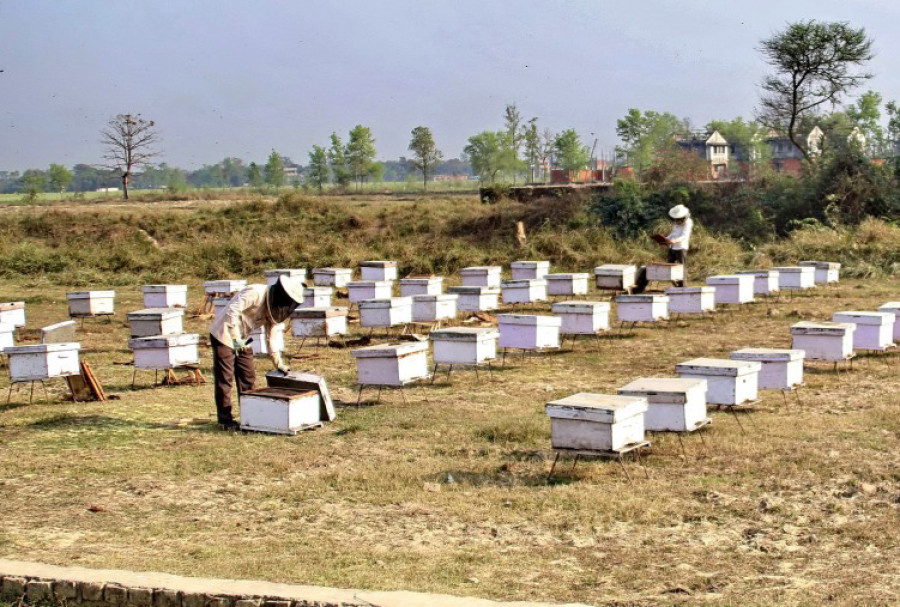Money
Ministry moves to expand the export basket to trim trade deficit
The widening trade deficit has hit foreign currency reserves.
Rajesh Khanal
The Ministry of Industry, Commerce and Supplies has identified 28 goods for export promotion as part of a move to trim the country's ballooning trade deficit.
The export products the ministry has listed as having a high comparative advantage are large cardamom, ginger, tea, medicinal and aromatic plants, yarn and textile, leather, footwear, Chyangra Pashmina, woollen carpets, coffee, vegetable and vegetable seeds, fruits and juices, honey, instant noodles, and handmade paper and paper products.
[Related Story: Revenues from exports of designated products up 7pc]
Other products that have been entered in the roster are readymade garments, semi-precious stones, silver jewellery, woollen products, flowers, handicrafts, lentils, jute bags and sacks, felt products, rosin and resin acid, rudrakchhya and bodhichitta, allo (Himalayan nettle) and Himalayan dog chew (chhurpi).
Kedar Bahadur Adhikari, secretary of the ministry, said the ministry had started promoting these goods through foreign diplomatic missions, Nepali embassies and donor agencies. “As the country has so far been unable to benefit to a large extent by relying on a few export items, the ministry has come up with these additional goods that are selling well in the international market,” said Adhikari.
The ministry had removed silvery jewellery, honey and handmade paper from the list when it revised the Nepal Trade Integration Strategy (NTIS) three years ago. Under this strategy, the ministry has listed nine products as having high export potential, down from 12 products originally.
[Related Story: Pashmina export revenues falling despite government incentives]
The new list has prioritised medicinal and aromatic plants, black cardamom, ginger and tea under agriculture products, and leather products, footwear products, readymade garment, pashmina and hand-knotted carpet under items with a high comparative advantage.
Complex trade procedures, high transit and transport costs, poor performance of the special economic zone in Bhairahawa and trade barriers on exports to India are among the main hurdles that the ministry has blamed for the soaring trade deficit.
Adhikari said the ministry had no plans to revise the existing NTIS list.
The latest statistics released by the Department of Customs show that Nepal's trade deficit swelled by 13.55 percent year-on-year to Rs1,321 billion in the last fiscal year 2018-19. The bloated deficit has been attributed to a massive import bill totalling Rs1,418 billion and slow export growth due to a small export basket.
The widening trade deficit has hit foreign currency reserves as Nepal splurges on ever rising imports. According to Nepal Rastra Bank, the country's foreign currency reserves are just sufficient to import goods and services for 7.7 months.
The ministry has sought coordination among government agencies to address the trade problem. “There should be effective implementation of the work plan recently issued by the government,” said Adhikari.
The work plan to reduce the trade deficit, which was endorsed by the Cabinet on May 16, assigns responsibilities to various government agencies. It urges the National Planning Commission to formulate sectoral policies to promote import substitution and export promotion.
The Ministry of Finance has been asked to assist investors in major export items, revise the duty on precious and semi-precious stones, and revise the tax rate on the import of prepared goods. The Ministry of Labour, Employment and Social Security has been asked to identify productive sectors where remittances can be invested.
The work plan advises Nepal Rastra Bank to increase the amount of soft loans for export-oriented products and simplify the related paperwork. Facilitating credit access to buy electric vehicles, lending against crop production, encouraging payment through letter of credit instead of telegraph transfer and discouraging auto loans are among the measures the government has sought from the central bank.




 12.12°C Kathmandu
12.12°C Kathmandu














